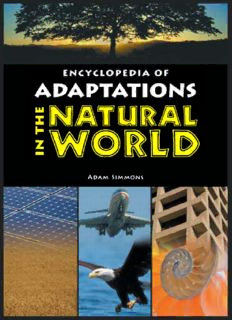
Encyclopedia of Adaptations in the Natural World PDF
Preview Encyclopedia of Adaptations in the Natural World
ENCYCLOPEDIA OF ADAPTATIONS IN THE NATURAL WORLD Adam Simmons G P REENWOOD RESS An Imprint of ABC-CLIO, LLC Copyright2010byAdamSimmons Allrightsreserved.Nopartofthispublicationmaybereproduced,storedina retrievalsystem,ortransmitted,inanyformorbyanymeans,electronic,mechanical, photocopying,recording,orotherwise,exceptfortheinclusionofbriefquotationsina review,withoutpriorpermissioninwritingfromthepublisher. LibraryofCongressCataloging-in-PublicationData Simmons,Adam. Encyclopediaofadaptationsinthenaturalworld/AdamSimmons. p.cm. Includesbibliographicalreferencesandindex. ISBN978–0–313–35556–1(hardcover:alk.paper)—ISBN978–0–313–35557–8(ebook) 1. Adaptation(Biology) I.Title. QH546.S576 2010 578.4—dc22 2009042504 14 13 12 11 10 1 2 3 4 5 ThisbookisalsoavailableontheWorldWideWebasaneBook. Visitwww.abc-clio.comfordetails. ABC-CLIO,LLC 130CremonaDrive,P.O.Box1911 SantaBarbara,California93116-1911 Thisbookisprintedonacid-freepaper ManufacturedintheUnitedStatesofAmerica ForMadge,Stan, Jack,and Josie myancestors CONTENTS Introduction xi About ThisBook xiii 1 Making and Using Energy 1 MakingandUsingEnergy—HumanInvention 1 Photosynthesis 3 Chemosynthesis 6 Catabolism 8 Ectothermy 12 ChemicalDefense—BombardierBeetle 14 ChemicalDefense—Devil’sGardenAnt 16 Electricity 19 Bioluminescence 21 2 Surviving the Elements 25 SurvivingtheElements—HumanInvention 25 ThermophilicBacteria—SurvivingExtremeHeat 28 BloodAntifreeze—SurvivingExtremeCold 31 MammalFur—SurvivingExtremeCold 33 Mangroves—SurvivingExtremeSalt 35 Lungfish—SurvivingwithoutOxygen 38 Melanin—SurvivingRadiation 40 Parasitism—SurvivingHostDefenses 42 Antibiotics—SurvivingDisease 45 Psychrophiles—SurvivingExtremeCold 47 Anhydrobiosis—SurvivingwithoutWater 49 Prions—SurvivingEverything 51 viii CONTENTS 3 Locomotion 55 Locomotion—HumanInvention 55 BirdFlight 58 InsectFlight 60 Running 63 Swimming—BluefinTuna 66 JetPropulsion 68 ParasiticLocomotion 70 Pollination 72 BacterialFlagellum 75 4 Materials 79 Materials—HumanInvention 79 Silk 82 Bone 84 Chitin 86 Feathers 89 Skin 92 Bio-ceramics 94 Mucus 96 NaturalGlues 98 GeckoFeet 100 Resilin 103 5 Building Structures 107 BuildingStructures—HumanInvention 107 TermiteTowers 109 Trees 112 BirdNests 115 BeaverLodges 117 BeeNests 120 PaperNests 122 CoralReefs 124 LuminousGnatTraps 127 NakedMoleRatBurrows 128 Diatoms 131 Webs 134 6 Sensing the Environment 137 SensingtheEnvironment—HumanInvention 137 VertebrateEyes 140 InsectEyes 142 Echolocation 144 Electrosense 147 FireandSmokeDetectors 149 InfraredVision 151 Jacobson’sOrganofSmell 153 OdorousGenes—TheMajorHistocompatibilityComplex 155 MagneticSense 158 InsectAntennae 160 CONTENTS ix SpecializedEyes 162 MantisShrimpEyes 165 7 Communication 169 Communication—HumanInvention 169 HumanBrain 171 HumanLanguage 174 PlantCommunication 177 BeeDanceLanguage 180 BacterialConjugation 182 Culture 184 DNA 187 Further Reading 191 Index 195 INTRODUCTION The ingenuity of the human race seemingly knows no bounds. From humble beginnings we have built staggering monuments, made breathtaking art, split the atom, and conquered space. On the cosmic scale, all this has been created in a blink of an eye—over a mere few thousand years in the planet’s 4.6 billion-year history. Now in the twenty-first century we continue to push the boundaries, makenewdiscoveries, andbuild moreremarkablemachines. We are rightly proud of our achievements. Our inventions have made our liveseasierandmorecomfortable.Manydiseases,oncedeadly,havenowbeen overcome with vaccines, antibiotics, and improved hygiene. The raw energies of our universe have been tamed to provide us with controllable power, and we protect ourselves from the extremes of the environment with intricately engineeredcocoons. We have come a long way since our first recognizable human ancestors walked the earth some 2.5 million years ago. We sometimes forget, though, thatweshareourplanetwithmanymillionsofothercreatures—otheranimals, plants,bacteria,fungi, protozoa,viruses,andeventiny,single,self-replicating strands of protein. Many of these creatures are small and extremely hard to spot,buttheyarethereand theyhavesurvivedformuchlongerthanwehave. Theirsuccessliesintheirownremarkableadaptationstothisplanet—perhaps not always so noticeable as our own adaptations, but ingenious adaptations nonetheless. Alllifeonearthisprogrammedtosurvive.Andaftersome3billionyearsof evolution it has become quite good at it—it has had to. On all sides, each and every organism on earth is faced with danger. From the elements. From its xii INTRODUCTION predators.Evenfromitsownkind.Afterallthis,itmustthenfindfood,water, and, ultimately,a mateif it is to successfullysurviveand pass onits genes. As we delve into the huge array of life on earth we find truly ingenious, astounding,anddownrightweirdadaptationsthathaveallowedlifetoflourish inthemostinhospitableofenvironments.Adaptationsthatalloworganismsto perceive the world in more detail than our most sophisticated microscopes, telescopes, andscanners. Adaptations that alloworganisms to move withsuch speed and agility that they make our advanced modes of transport look slug- gish. Adaptations that produce materials of such strength and flexibility that we havenot comecloseto replicatingthem. Overmillionofyearsofevolution,lifehasadaptedwell totheharshcondi- tions of our planet in exactly the same way we have. Human engineers tinker away at a rough plan,making tiny adjustments to honetheir designto perfec- tion. Nature does the same. The evolutionary biologist Richard Dawkins described nature as a blind watchmaker. It may not see and plan the tiny changes it makesto itsdesign,but it knowswhensomethingis working. Thisishowevolutionworks.Physicalandbehavioraltraitsarecodedforon the genetic material, DNA, held within every cell of every living organism. Small mistakes and alterations in this genetic code that occur as organisms reproduce lead to tiny changes in the traits we see. Some of these changes can be harmful and result in the new individual dying earlier or producing fewer offspring than if the change had not happened at all. These deleterious changes in the gene pool will eventually be lost. Other changes, though, will bebeneficial.Theywillcodeforimprovedeyesight,greaterphysicalstrength, oranewbehaviorthatgivesanindividualacompetitiveadvantageoverothers of its species. These changes will tend to be preserved in the gene pool. Over time, these changes can be honed by natural selection to produce the special- ized adaptations weseein nature today. Manyadaptationshaveevolvedthatmatchorevensurpassourownachieve- ments. Why else would today’s scientists be so keen in borrowing so much of what has been created in nature? This book seeks to capture the most funda- mentaloftheseadaptations,someofwhichmaybefamiliartoyoufromdistant (orperhapsnotsodistant)schooldays.Otherswillbecompletelynew.Ihope thatyouwilllookonthoseyouknewinanewlight,andthoseyoudidn’twitha desire to know more. Theparallels of theseadaptationswithour owndriveforsurvival areclose. After all, humans are organisms like any other in this planet. We have much more in common with the other creatures who live on this planet than we might think. Viruses, bacteria, single-cell protozoa, plants, and animals (our- selves included) are all driven to survive. It is from this race for survival that many remarkablewilddesigns haveemerged. ABOUT THIS BOOK Ashumans,weareawareofthegreatchallengestoourownsurvival.Beingan animallikethemanythousandsofothersonthisplanet,itshouldnotcomeasa surprise that the challenges we face are those faced every day by every other species on earth. This book is divided into seven chapters that group these challenges together: Making andUsingEnergy Survivingthe Elements Locomotion Materials Building Structures Sensing theEnvironment Communication Each chapter begins with a short history of the human achievements and inventions in that field that have led to our success. As the rest of the chapter will show, though, evolution has created similar adaptations that match and surpass our own. Each of these adaptations is set out in its own entry, with the aim that the reader can dip into the book according to his or her interest —either for research or curiosity. At the end of every adaptation entry is a short section called ‘‘Borrowing from Nature’’ that shows how human engi- neers, scientists, and inventors are directly taking what they see in nature and developingit forthe advancementof humanendeavor. Evolutionand biology, like all the sciences,havetheirownjargon that can, to the lay person and expert alike, be baffling at times. I have therefore
Description: